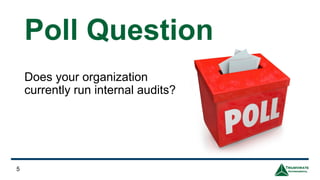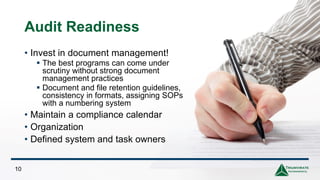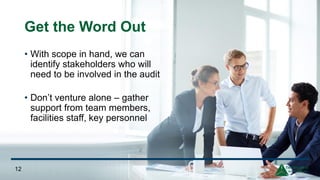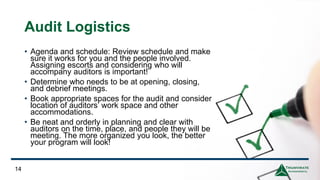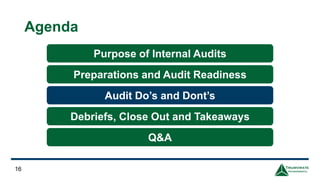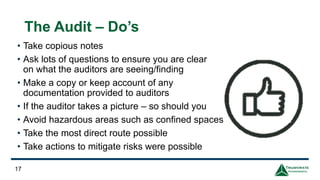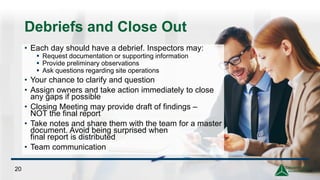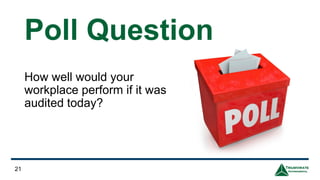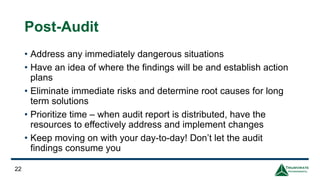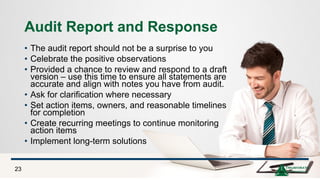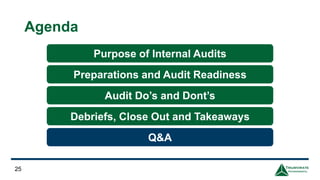Internal Audits and Other Tactics to Improve Your EHS Program
- 1. Internal Audits and Other Tactics to Improve Your EHS Program Grace Rosario, EHS Consultant Triumvirate Environmental
- 2. Meet Your Moderator 2 Nita Vaidya
- 3. 3 During this Webinar ✓ All lines will be muted. ✓ Communicate via the questions tab in your webinar panel. ✓ Unanswered questions will be responded to personally after the webinar. ✓ Webinar recording and slides will be emailed to you tomorrow.
- 4. Grace Rosario EHS Consultant Triumvirate Environmental 4 Meet Your Presenter
- 5. Poll Question Does your organization currently run internal audits? 5
- 6. Agenda 6 Purpose of Internal Audits Preparations and Audit Readiness Audit Do’s and Dont’s Debriefs, Close Out and Takeaways Q&A
- 7. Purpose • Corporate, internal audits are a form of quality assurance in many industries • Inspection of current processes and management systems to evaluate gaps without a regulatory burden • Proactive effort to get ahead of any regulatory audits • Confidence in your EHS program’s audit readiness at all times 7
- 8. Internal vs. External Audits 8 Internal Audit External Audit • A self-driven evaluation • A “dress rehearsal” to test preparedness for external audits and inspections • Performance and results DO matter: − A reflection of the site’s (and individual) performance in the eyes of the company’s senior leadership o Need to instill confidence that compliance and key risks are well managed − Results may be used to benchmark against other locations • Initiated and performed by a third party (regulatory agencies, certification registrars, and insurance companies) • The “real thing” (not a dress rehearsal) • Performance (good and poor) may result in: − Issuance or renewal of permit, license, certification, or registration − Citation, fine, or penalty issued by the third-party organization or relevant interested party − Impacts to business continuity (shutdown of facilitiy or loss of license/permit) or impacts to company reputation
- 9. Agenda 9 Purpose of Internal Audits Preparations and Audit Readiness Audit Do’s and Dont’s Debriefs, Close Out and Takeaways Q&A
- 10. Audit Readiness 10 • Invest in document management! ▪ The best programs can come under scrutiny without strong document management practices ▪ Document and file retention guidelines, consistency in formats, assigning SOPs with a numbering system • Maintain a compliance calendar • Organization • Defined system and task owners
- 11. Audit Scope • Understand audit scope and areas of focus ▪ Often will focus on recently released procedures or updated processes • Ask for scope if one is not provided! • Prepare and organize supporting information around the scope • Ensure programs, procedures, and personnel involved in the audit scope areas are in good working order • Are we doing what we say we are doing? 11
- 12. Get the Word Out • With scope in hand, we can identify stakeholders who will need to be involved in the audit • Don’t venture alone – gather support from team members, facilities staff, key personnel 12
- 13. Review Past Audits • Familiarize yourself with previous audit findings ▪ Avoid repeat findings! • Run through findings and assess controls currently in place • Use past audits as a gap analysis for upcoming audit • Include stakeholders and key personnel in previous audit findings – all involved should have good understanding of progress being made, where you were, and improvements 13
- 14. Audit Logistics 14 • Agenda and schedule: Review schedule and make sure it works for you and the people involved. Assigning escorts and considering who will accompany auditors is important! • Determine who needs to be at opening, closing, and debrief meetings. • Book appropriate spaces for the audit and consider location of auditors’ work space and other accommodations. • Be neat and orderly in planning and clear with auditors on the time, place, and people they will be meeting. The more organized you look, the better your program will look!
- 15. Audit Timeline • Reception, site introduction, safety briefing • Opening meeting – review of scope, agenda, schedule • Introductory tour • Interviews, document reviews, topical tours • Daily debriefs • Closing meeting 15
- 16. Agenda 16 Purpose of Internal Audits Preparations and Audit Readiness Audit Do’s and Dont’s Debriefs, Close Out and Takeaways Q&A
- 17. The Audit – Do’s • Take copious notes • Ask lots of questions to ensure you are clear on what the auditors are seeing/finding • Make a copy or keep account of any documentation provided to auditors • If the auditor takes a picture – so should you • Avoid hazardous areas such as confined spaces • Take the most direct route possible • Take actions to mitigate risks were possible 17
- 18. During the Audit – Don’ts • Don’t offer opinions or additional information in excess to inspector’s question • Don’t be his or her “buddy” • Don’t be overly confrontational or show frustration • Don’t be afraid to say “I don’t know” • Don’t be afraid to ask for clarification if you don’t understand or agree with something • Don’t speculate or assume • Don’t be evasive. Be direct, succinct, clear in responses • Don’t lie! 18
- 19. Agenda 19 Purpose of Internal Audits Preparations and Audit Readiness Audit Do’s and Dont’s Debriefs, Close Out and Takeaways Q&A
- 20. Debriefs and Close Out • Each day should have a debrief. Inspectors may: ▪ Request documentation or supporting information ▪ Provide preliminary observations ▪ Ask questions regarding site operations • Your chance to clarify and question • Assign owners and take action immediately to close any gaps if possible • Closing Meeting may provide draft of findings – NOT the final report • Take notes and share them with the team for a master document. Avoid being surprised when final report is distributed • Team communication 20
- 21. Poll Question How well would your workplace perform if it was audited today? 21
- 22. Post-Audit • Address any immediately dangerous situations • Have an idea of where the findings will be and establish action plans • Eliminate immediate risks and determine root causes for long term solutions • Prioritize time – when audit report is distributed, have the resources to effectively address and implement changes • Keep moving on with your day-to-day! Don’t let the audit findings consume you 22
- 23. Audit Report and Response • The audit report should not be a surprise to you • Celebrate the positive observations • Provided a chance to review and respond to a draft version – use this time to ensure all statements are accurate and align with notes you have from audit. • Ask for clarification where necessary • Set action items, owners, and reasonable timelines for completion • Create recurring meetings to continue monitoring action items • Implement long-term solutions 23
- 24. Takeaways • Gain a different perspective on your programs • Identify positive observations and improvement opportunities ▪ Chance to shine, show off your hard work • Document management and organizational tools will continue to strengthen your program • Preparedness is not a one-time value – programs will be in place if and when an external auditor comes knocking 24
- 25. Agenda 25 Purpose of Internal Audits Preparations and Audit Readiness Audit Do’s and Dont’s Debriefs, Close Out and Takeaways Q&A
- 26. Questions?





